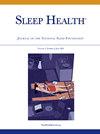Family implication in adolescents’ sleep: A qualitative exploration with quantitative insights
IF 3.4
2区 医学
Q2 CLINICAL NEUROLOGY
引用次数: 0
Abstract
Introduction
The multiple changes in sleep patterns during adolescence are influenced by both biological and environmental factors, resulting in later bedtimes and insufficient sleep. Since most adolescents live with their families, the family environment plays a crucial role in shaping adolescent sleep behaviors. Existing research on this topic remains limited.
Methods
This study employed both qualitative and quantitative methods to explore family involvement in adolescent sleep. A total of 114 participants (31 families, including both parents, siblings, and the target adolescents) participated in semistructured interviews and wore actigraphs to measure sleep over 7 days.
Results
Actigraphy results revealed that most adolescents slept less than the recommended amount, with similar sleep patterns observed between adolescents, their siblings, and mothers. Thematic content analysis identified how sleep behaviors and attitudes were transmitted within families. Similar habits in the evening were observed between family members, such as meals, screen time, reading, and homework.
Discussion
The study highlighted how family members model behaviors related to sleep, with parents and siblings influencing adolescents’ sleep patterns. Parental roles, such as setting sleep-related rules, limiting screen time, and maintaining consistent bedtime routines, serve as key behavioral models that adolescents often adopt, leading to better sleep quality and quantity.
Conclusion
This study underscores the significant role of family in shaping adolescent sleep patterns through both explicit behaviors and implicit modeling.
青少年睡眠的家庭影响:一项具有定量见解的定性探索。
青少年时期睡眠模式的多重变化受到生物和环境因素的双重影响,导致就寝时间晚,睡眠不足。由于大多数青少年与家人一起生活,家庭环境在塑造青少年睡眠行为方面起着至关重要的作用。关于这一主题的现有研究仍然有限。方法:采用定性与定量相结合的方法,探讨家庭对青少年睡眠的影响。114名参与者(31个家庭,包括父母双方、兄弟姐妹和目标青少年)参加了半结构化访谈,并佩戴了活动记录仪来测量7天内的睡眠情况。结果:活动描记结果显示,大多数青少年睡眠少于推荐量,在青少年、他们的兄弟姐妹和母亲之间观察到相似的睡眠模式。主题内容分析确定了睡眠行为和态度是如何在家庭中传播的。在晚上,家庭成员之间也有类似的习惯,比如吃饭、看屏幕、阅读和做作业。讨论:该研究强调了家庭成员如何塑造与睡眠相关的行为,父母和兄弟姐妹影响青少年的睡眠模式。父母的角色,如设定与睡眠有关的规则,限制屏幕时间,保持一致的就寝时间,是青少年经常采用的关键行为模式,从而提高睡眠质量和睡眠量。结论:本研究强调了家庭通过外显行为和内隐行为塑造青少年睡眠模式的重要作用。
本文章由计算机程序翻译,如有差异,请以英文原文为准。
求助全文
约1分钟内获得全文
求助全文
来源期刊

Sleep Health
CLINICAL NEUROLOGY-
CiteScore
6.30
自引率
9.80%
发文量
114
审稿时长
54 days
期刊介绍:
Sleep Health Journal of the National Sleep Foundation is a multidisciplinary journal that explores sleep''s role in population health and elucidates the social science perspective on sleep and health. Aligned with the National Sleep Foundation''s global authoritative, evidence-based voice for sleep health, the journal serves as the foremost publication for manuscripts that advance the sleep health of all members of society.The scope of the journal extends across diverse sleep-related fields, including anthropology, education, health services research, human development, international health, law, mental health, nursing, nutrition, psychology, public health, public policy, fatigue management, transportation, social work, and sociology. The journal welcomes original research articles, review articles, brief reports, special articles, letters to the editor, editorials, and commentaries.
 求助内容:
求助内容: 应助结果提醒方式:
应助结果提醒方式:


